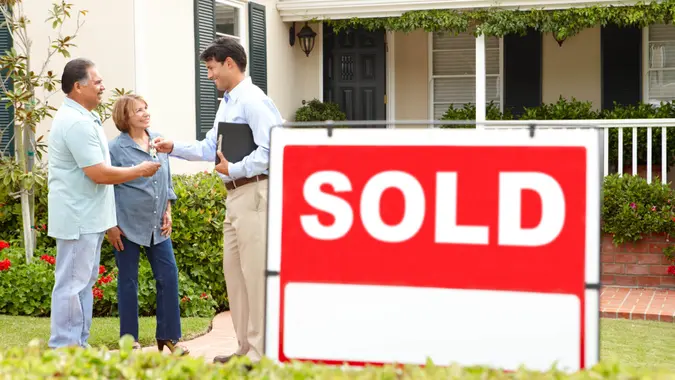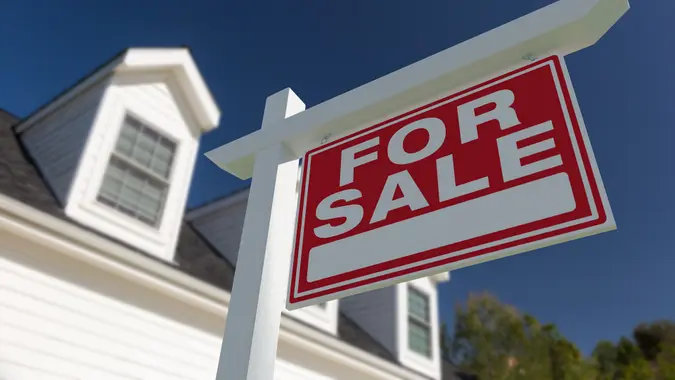45% of US Homebuyers Are Purchasing Mortgage Points — How Much Will It Lower Your Interest Rate?

Commitment to Our Readers
GOBankingRates' editorial team is committed to bringing you unbiased reviews and information. We use data-driven methodologies to evaluate financial products and services - our reviews and ratings are not influenced by advertisers. You can read more about our editorial guidelines and our products and services review methodology.

20 Years
Helping You Live Richer

Reviewed
by Experts

Trusted by
Millions of Readers
As long as the housing market remains erratic, prospective buyers will continue to look for ways to improve their chances of achieving homeownership. If you plan on settling down and don’t expect to refinance your mortgage soon, purchasing mortgage points could be a smart money-saving plan.
Americans are increasingly using this mortgage option when negotiating a new home loan or cash-out refinancing. Using data from the Home Mortgage Disclosure Act (HMDA), Zillow Home Loans found that that nearly 45% of primary home borrowers chose to buy mortgage point in 2022, up significantly from 29.6% in 2021. Among homeowners refinancing their home, 57.8% who elected a cash-out refinance bought points in 2022 compared with 48.4% in 2021.
I’m a Real Estate Agent: Here Are the 6 Cities Where You Should Avoid Buying a Home This Summer
What Are Mortgage Points?
Mortgage points, or discount points, are loan interest that borrowers can pay upfront to their lender at the time of closing in exchange for a lower interest rate on their mortgage. Each point costs 1% of the total loan amount.
A homeowner who has the funds to purchase mortgage points and wants to lower their monthly payments might find it worthwhile if they stay in the home long enough to recoup the upfront cost, which can take a number of years.
Buying points might help prospective homebuyers qualify for their loans by reducing their monthly payments. What’s more, because the points are prepaid mortgage interest, their cost could be an itemizable tax deduction.
Conversely, a borrower might not need to buy points when mortgages rates are already low and the market favorable. It also makes sense for borrowers to forgo points when they have limited funds and/or if they expect to sell or refinance within a few years, before they’ve broken even on the upfront payment.
Good To Know: You might also hear the term “points” in relation to origination fees. An origination fee is the fee lenders charge to originate the loan. The fee amount is expressed in points because it’s typically a percentage of the loan amount — a 1% origination fee equals one point. However, origination points are unrelated to discount points.
How Do Mortgage Points Work?
The idea is that by paying these points, borrowers can “buy down” their interest rate and save money on their mortgage payments over the life of the loan. The reduction in interest rate due to mortgage points can vary based on the lender and current market conditions.
Typically, one mortgage point lowers your interest rate by 0.25%. So, if you were offered a 4.00% interest rate on a mortgage without any points, purchasing one mortgage point might reduce the interest rate to 3.75% (4.00% – 0.25%). Similarly, if you decide to purchase two points, you might see a total reduction of 0.50% (4.00% – 0.50%), resulting in an interest rate of 3.50%.
To use an example from Bank of America, suppose you’re taking out a $200,000 mortgage with a 30-year term at an interest rate of 4.5%, and the lender offers you the option to pay one point (1% of the loan amount) at closing for a reduced interest rate of 4.25%. In this case, paying the one point would cost you $2,000 (1% of $200,000).
This mortgage point purchase will result in a monthly savings of $29.49 per month and $10,616.40 over your 30-year mortgage loan. Using this example, it would take almost 68 months, or around 5.7 years, to recoup the $2,000 upfront cost, or “break even.” The buydown becomes financially beneficial after the break-even point.
Keep in mind that the amount of interest rate reduction discount points provide can vary depending on market conditions and lender terms. It’s essential to carefully evaluate the options and do the math to determine whether buying points meshes with your financial goals and how long you plan to have the mortgage.
 Written by
Written by  Edited by
Edited by 

























